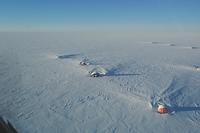Frozen climate of the past
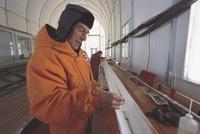
Geologists extract the soils to know the characteristics of the soil of the leg: characteristics of the lands or rocks, layers, depth, etc. They are used for infrastructure works, site location or paleontological research, for example. But they can also be obtained in ice and used to know the weather or environmental conditions of the past, paleoclimatology.
The deeper the hole, the older the ice, and the further back it can be done in history. In Greenland there have been surveys of 3,053 meters of depth to extract the ice. And in the rock under ice have dug up to 1.55 meters.
Also in Antarctica more than 3,500 meters have been excavated at Concordia station, obtaining samples of 900,000 years ago. On Lake Vostok the beds have been gained to a similar depth. However, the ice is not so old and have obtained samples from 400,000 years ago.
Interpretation of hills
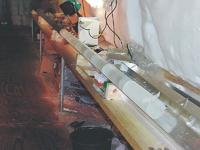
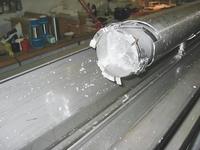
One of the things researchers study is the thickness of the medullary layers, which allows them to know the rainfall of each time of the year. This is basic information, so to speak, of the time of each epoch.
But you can also access the atmosphere information. The air bubbles trapped in the cloud and later imprisoned in the ice report on the composition of the atmosphere of the time (CO 2, CH 4 ..). In addition, the study of the isotopic composition of snow oxygen allows interpreting the changes of the seasons to know the temperature at which each layer was formed.
In addition, the size and magnitude of the captured particles allow to deduce atmospheric circulations. And by analyzing other physical-chemical parameters of ice, such as electrical conductivity, more information is obtained.
In the end, the sum of all these partial information allows researchers to know the climate of yesteryear.
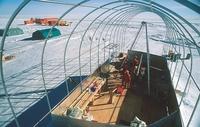
However, in addition to those directly related to the weather, additional information can also be obtained through the ice. For example, there is the footprint of the main volcanic eruptions. Also traces of lead produced 2,000 years ago by Roman industrial activity, nuclear tests conducted in the 1950s or the increase of greenhouse gases of the last 200 years.
International studies
There are many studies carried out in both the North Pole and the South Pole. However, most research programs are somehow related to climate. And it is very common that research is carried out among several groups or states, especially in the South Pole, to reduce costs. For example, since 1995 the European Ice Polling Project, promoted by the European Commission and the European Science Foundation, in which a dozen European countries participate, has been underway in Antarctica.
Since the beginning of the project, surveys have been conducted in two points: at Concordia station, also known as Dome, and at Kohn station. After eight years, cores of more than 3,500 meters deep were acquired, obtaining records of the last 900,000 years. The results were published in the journal Nature in 2004 and the article highlights three results.
Thus, in the last 740,000 years, the Earth has known 8 climatic cycles alternating glaciations and interglacial periods, in which a sudden change occurred 420,000 years ago. Thus, in the warmer times of the last 420,000 years the temperature was similar to the current one, while the warmer earlier times were somewhat cooler but longer.

In addition, they have discovered that in the period of change 420,000 years ago the longest glacial art occurred: It lasted about 28,000 years. They consider it as the current glacial art, since the astronomical conditions and the orbit and axis of the Earth were equal to the present. Consequently, the next glaciation would not arrive until a few millennia later.
And the third result of the analysis of the air bubbles trapped in the ice indicates that the highest concentration of greenhouse gases in the last 440,000 years is the current one.
In fact, studies related to the greenhouse effect also abound in the Poles, in addition to studies that analyze the characteristics of the climate.
The greenhouse effect and climate
The study of ice has revealed that in the last 420,000 years the atmospheric concentration of CO 2 and CH 4 has changed continuously. During glaciations, the concentration of both gases has decreased with temperature and increased in interglaciations. But what causes it? Do temperature changes change the gas concentration or vice versa?
It seems that the climate changes read in the ice metrics were due to astronomical events such as the distance to the Sun or the inclination of the Earth's axis. However, after commissioning, the effects of increased or decreased atmospheric gases have increased or decreased.
For example, methane is produced in fermentation by bacteria from swampy periglacial regions. Astronomical events when melting permafrost cause a large amount of methane by bacteria, contributing to the greenhouse effect. This increases the temperature and melts more permafrost. On the contrary, at the beginning of the glaciation, the first colds provoke the appearance of bacteria and considerably reduce methane production and atmospheric methane concentration, while decreasing the greenhouse effect and increasing the decrease in temperatures.
The same would have happened with marine CO 2 and phytoplankton.
It has been said that the poles carry out mainly climate-related research, but they are not the only ones. Glaciology, thermohaline circulation, study of the atmosphere, biology, astrophysical research, meteorite collection and analysis, neutrino detection, space technology testing, psychobiological and psychosociological research of scientists working isolated in stations, etc., are performed at the poles. Therefore, it is understandable that scientists pretend that poles, and especially Antarctica, are used exclusively for research, apart from other farms.
